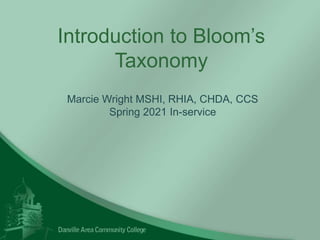
ORIENTATION BLOOM.ppt
- 1. Introduction to Bloom’s Taxonomy Marcie Wright MSHI, RHIA, CHDA, CCS Spring 2021 In-service
- 2. What is Bloom’s? •Is an instructional theory that categorizes levels of learning. •A tool for instructors to assist with writing learning outcomes, curriculum planning, content delivery as well as assessment of learning levels.
- 3. Bloom’s Levels • Each level has a list of action verbs to identify the type of cognitive activity being performed by the student. • Remember is the lowest level using action verbs- memorize, reproduce, or recognize facts and terms. • Each step-up builds on the one below requiring a higher level of thinking and more difficult learning activities.
- 4. Bloom’s Taxonomy Remember: To memorize, reproduce, or recognize facts and terms Knowledge through Evaluation from: Bloom, B. & Associates (1956). Taxonomy of educational objectives. New York, NY: David McKay. Remembering through Creating from: Anderson, L. W., & Krathwohl, D. R. (2000). A taxonomy for learning, teaching, and assessing: A revision of Bloom's Taxonomy of Educational Objectives. Boston, MA: Allyn & Bacon. “Revised Bloom's Taxonomy.” CELT, Iowa State University Center for Excellence in Learning and Teaching, www.celt.iastate.edu/teaching/effective-teaching- practices/revised-blooms-taxonomy/. Understand: To describe, translate or restate in one’s own words Apply: To utilize, apply or make useful Analyze: To identify and examine components, compare and/or contrast properties, identify assumptions, or deduce implications Evaluate: To make a judgement, determine validity of a claim, or select and defend a position Create: To make connections, identify new relationships, or design something new (new to students)
- 5. How to Use Blooms 1. Use Bloom’s action verbs to write learning outcomes. 2. Use Bloom’s levels to structure course content (curriculum mapping). 3. Use Bloom’s to assess/measure student progress.
- 6. Writing learning outcomes 1. Use Bloom’s action verbs to write learning outcomes. Example: Student will be able to: Apply diagnosis and procedure codes according to current guidelines with 70% accuracy or better - Blooms level (3) “Level 3”
- 7. Structure Course Content 1. Using Bloom’s to plan: begin at a lower level Bloom’s category. As the student develops more skill/understanding the activities’ difficulty (Bloom’s level) also increases. 2. Plan learning outcomes first so that course content aligns with learning goals (so a course does not start with the most difficult material). 3. Test Blueprinting and Curriculum Mapping are tools that help structure course content.
- 8. Using Blooms to Assess Course activities are designed to assess a student’s knowledge/skill level. Examples of question types and common Bloom’s level: a. Multiple choice questions = Remember (Bloom’s 1) b. Summarize an article = Understand (Bloom’s 2) c. Analyze case study = Analyzing (Bloom’s 4) d. Create a spreadsheet = Creating (Bloom’s 6)
- 9. Resources • Visit the Assessment Website: www.dacc.edu/assessment • Preville, Philip “The Professor’s Guide to Using Bloom’s Taxonomy.” Tophat.com. Retrieved December 15, 2020. https://tophat.com/teaching- resources/ebooks-and-guides/blooms-taxonomy- guide/